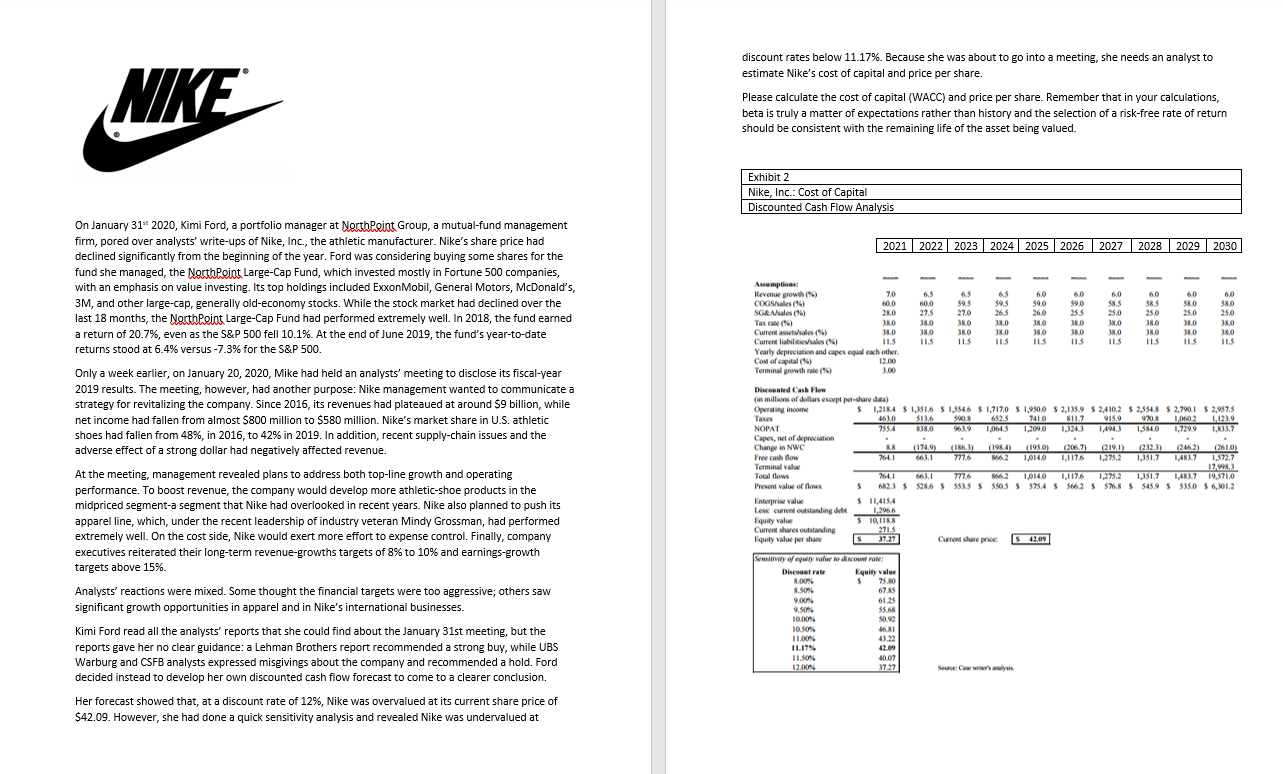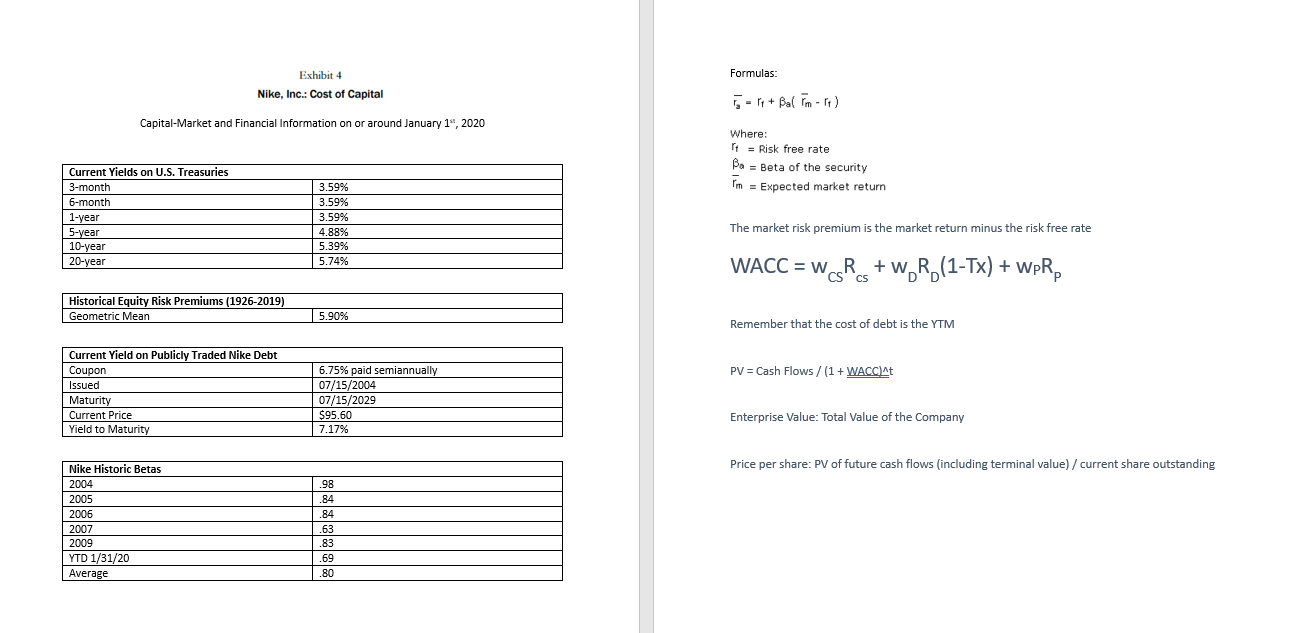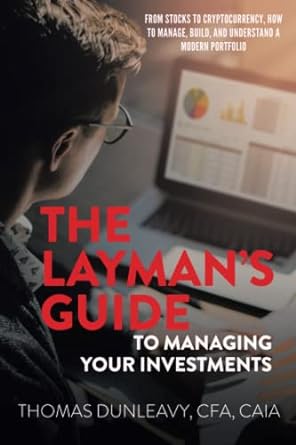

discount rates below 11.17%. Because she was about to go into a meeting, she needs an analyst to estimate Nike's cost of capital and price per share. NIKE Please calculate the cost of capital (WACC) and price per share. Remember that in your calculations, beta is truly a matter of expectations rather than history and the selection of a risk-free rate of return should be consistent with the remaining life of the asset being valued. Exhibit 2 Nike, Inc.: Cost of Capital | Discounted Cash Flow Analysis | 2021 2022 2023 2024 2025 2026 2027 2028 2029 2030 On January 31" 2020, Kimi Ford, a portfolio manager at NorthPoint Group, a mutual fund management firm, pored over analysts' write-ups of Nike, Inc., the athletic manufacturer. Nike's share price had declined significantly from the beginning of the year. Ford was considering buying some shares for the fund she managed, the North Point Large-Cap Fund, which invested mostly in Fortune 500 companies, with an emphasis on value investing. Its top holdings included ExxonMobil, General Motors, McDonald's, 3M, and other large-cap, generally old-economy stocks. While the stock market had declined over the last 18 months, the North Point Large-Cap Fund had performed extremely well. In 2018, the fund earned a return of 20.7%, even as the S&P 500 fell 10.1%. At the end of June 2019, the fund's year-to-date returns stood at 6.4% versus -7.3% for the S&P 500. 595 26.5 990 255 $8 25.0 SRS 25.0 Assumptions Revenue growth (%) COX () 0 SGRM (96) 200 Tax rate(%) Currena les (%) Current liabilitiales (%) 11.5 Yearly depreciation and capex equal each other. Cost of capital (96) 12.00 Terminal growth rate (%) 6,5 60,0 27.5 38,0 38.0 11.3 595 27.0 380 38.0 113 6.0 590 26.0 380 38.0 114 80 250 380 380 114 58.0 25.0 38,0 38.0 113 10 380 113 380 115 38, 0 116 3 8.0 115 Only a week earlier, on January 20, 2020, Mike had held an analysts' meeting to disclose its fiscal-year 2019 results. The meeting, however, had another purpose: Nike management wanted to communicate a strategy for revitalizing the company. Since 2016, its revenues had plateaued at around $9 billion, while net income had fallen from almost 5800 million to $580 million. Nike's market share in U.S. athletic shoes had fallen from 48%, in 2016, to 42% in 2019. In addition, recent supply-chain issues and the adverse effect of a strong dollar had negatively affected revenue. Diented Cash Flow in millions of dollars exopt pershare data) Operating income $ 2184 5 1,3516 $ 15546 5 1.7170 S 1, 000 2.13 $24102 25545 5 2.700 52.0575 Tanes 10 11 9 71 0 117915992031.0 21.12.9 NOPAT 735.4 8.0 19 106.5 12000 123 1,49 1,384,0 1,729,9 1,833.7 Cape, net of depreciation Change in NWC (1749) (1863) (1984) (1950) (067) 219.1) 2123) 462) ( 10) Free cash flow 7641 663,1 7776 862 10140 1,1176 1,275,2 1,351.7 1,483,7 1,972.7 Terminal value 17,98,3 Total flows 7641 663. 1 7 776 66.2 1,014.0 1.1176 1,275,2 1,351.7 1,483.7 19,571.0 Present value of flows 6623 28.6 5 5515 590.5 575.4 S 5662 5 5768 $ 545.95 $350 $6,3012 Enterprise value $ 11,4154 Les c outstanding de 1,2966 Equity value 5 10,1168 Current shares outstanding Equity value share Current share price. 12.00 At the meeting, management revealed plans to address both top-line growth and operating performance. To boost revenue, the company would develop more athletic-shoe products in the midpriced segment-a segment that Nike had overlooked in recent years. Nike also planned to push its apparel line, which, under the recent leadership of industry veteran Mindy Grossman, had performed extremely well. On the cost side, Nike would exert more effort to expense control. Finally, company executives reiterated their long-term revenue-growths targets of 8% to 10% and earnings-growth targets above 15%. Seniowy ofwlywo Discount rate 8.00 owww ! Equity value $ 75.00 6785 Analysts' reactions were mixed. Some thought the financial targets were too aggressive; others saw significant growth opportunities in apparel and in Nike's international businesses. 61.25 9.00 9. Son 10.00 10 SON 11.00% 43.22 Kimi Ford read all the analysts' reports that she could find about the January 31st meeting, but the reports gave her no clear guidance: a Lehman Brothers report recommended a strong buy, while UBS Warburg and CSFB analysts expressed misgivings about the company and recommended a hold. Ford decided instead to develop her own discounted cash flow forecast to come to a clearer conclusion. 1200 17:27 Her forecast showed that, at a discount rate of 12%, Nike was overvalued at its current share price of $42.09. However, she had done a quick sensitivity analysis and revealed Nike was undervalued at Formulas: Exhibit 4 Nike, Inc.: Cost of Capital 5 = 8 + Balim - 1) Capital-Market and Financial Information on or around January 1, 2020 Where: 1+ = Risk free rate Ba = Beta of the security Im = Expected market return Current Yields on U.S. Treasuries 3-month 6-month 1-year 5-year 10-vear 20-year 3.59% 3.59% 3.59% 4.88% 5.39% 5.74% The market risk premium is the market return minus the risk free rate WACC = WSR + w, R. (1-Tx) + WpRp Historical Equity Risk Premiums (1926-2019) Geometric Mean 5.90% Remember that the cost of debt is the YTM PV = Cash Flows /(1+ WACC) At Current Yield on Publicly Traded Nike Debt Coupon Issued Maturity Current Price Yield to Maturity 6.75% paid semiannually 07/15/2004 07/15/2029 $95.60 7.17% Enterprise Value: Total Value of the Company Price per share: PV of future cash flows (including terminal value) / current share outstanding 98 Nike Historic Betas 2004 2005 2006 1.84 .84 .63 .83 2009 YTD 1/31/20 Average .69 1.80 discount rates below 11.17%. Because she was about to go into a meeting, she needs an analyst to estimate Nike's cost of capital and price per share. NIKE Please calculate the cost of capital (WACC) and price per share. Remember that in your calculations, beta is truly a matter of expectations rather than history and the selection of a risk-free rate of return should be consistent with the remaining life of the asset being valued. Exhibit 2 Nike, Inc.: Cost of Capital | Discounted Cash Flow Analysis | 2021 2022 2023 2024 2025 2026 2027 2028 2029 2030 On January 31" 2020, Kimi Ford, a portfolio manager at NorthPoint Group, a mutual fund management firm, pored over analysts' write-ups of Nike, Inc., the athletic manufacturer. Nike's share price had declined significantly from the beginning of the year. Ford was considering buying some shares for the fund she managed, the North Point Large-Cap Fund, which invested mostly in Fortune 500 companies, with an emphasis on value investing. Its top holdings included ExxonMobil, General Motors, McDonald's, 3M, and other large-cap, generally old-economy stocks. While the stock market had declined over the last 18 months, the North Point Large-Cap Fund had performed extremely well. In 2018, the fund earned a return of 20.7%, even as the S&P 500 fell 10.1%. At the end of June 2019, the fund's year-to-date returns stood at 6.4% versus -7.3% for the S&P 500. 595 26.5 990 255 $8 25.0 SRS 25.0 Assumptions Revenue growth (%) COX () 0 SGRM (96) 200 Tax rate(%) Currena les (%) Current liabilitiales (%) 11.5 Yearly depreciation and capex equal each other. Cost of capital (96) 12.00 Terminal growth rate (%) 6,5 60,0 27.5 38,0 38.0 11.3 595 27.0 380 38.0 113 6.0 590 26.0 380 38.0 114 80 250 380 380 114 58.0 25.0 38,0 38.0 113 10 380 113 380 115 38, 0 116 3 8.0 115 Only a week earlier, on January 20, 2020, Mike had held an analysts' meeting to disclose its fiscal-year 2019 results. The meeting, however, had another purpose: Nike management wanted to communicate a strategy for revitalizing the company. Since 2016, its revenues had plateaued at around $9 billion, while net income had fallen from almost 5800 million to $580 million. Nike's market share in U.S. athletic shoes had fallen from 48%, in 2016, to 42% in 2019. In addition, recent supply-chain issues and the adverse effect of a strong dollar had negatively affected revenue. Diented Cash Flow in millions of dollars exopt pershare data) Operating income $ 2184 5 1,3516 $ 15546 5 1.7170 S 1, 000 2.13 $24102 25545 5 2.700 52.0575 Tanes 10 11 9 71 0 117915992031.0 21.12.9 NOPAT 735.4 8.0 19 106.5 12000 123 1,49 1,384,0 1,729,9 1,833.7 Cape, net of depreciation Change in NWC (1749) (1863) (1984) (1950) (067) 219.1) 2123) 462) ( 10) Free cash flow 7641 663,1 7776 862 10140 1,1176 1,275,2 1,351.7 1,483,7 1,972.7 Terminal value 17,98,3 Total flows 7641 663. 1 7 776 66.2 1,014.0 1.1176 1,275,2 1,351.7 1,483.7 19,571.0 Present value of flows 6623 28.6 5 5515 590.5 575.4 S 5662 5 5768 $ 545.95 $350 $6,3012 Enterprise value $ 11,4154 Les c outstanding de 1,2966 Equity value 5 10,1168 Current shares outstanding Equity value share Current share price. 12.00 At the meeting, management revealed plans to address both top-line growth and operating performance. To boost revenue, the company would develop more athletic-shoe products in the midpriced segment-a segment that Nike had overlooked in recent years. Nike also planned to push its apparel line, which, under the recent leadership of industry veteran Mindy Grossman, had performed extremely well. On the cost side, Nike would exert more effort to expense control. Finally, company executives reiterated their long-term revenue-growths targets of 8% to 10% and earnings-growth targets above 15%. Seniowy ofwlywo Discount rate 8.00 owww ! Equity value $ 75.00 6785 Analysts' reactions were mixed. Some thought the financial targets were too aggressive; others saw significant growth opportunities in apparel and in Nike's international businesses. 61.25 9.00 9. Son 10.00 10 SON 11.00% 43.22 Kimi Ford read all the analysts' reports that she could find about the January 31st meeting, but the reports gave her no clear guidance: a Lehman Brothers report recommended a strong buy, while UBS Warburg and CSFB analysts expressed misgivings about the company and recommended a hold. Ford decided instead to develop her own discounted cash flow forecast to come to a clearer conclusion. 1200 17:27 Her forecast showed that, at a discount rate of 12%, Nike was overvalued at its current share price of $42.09. However, she had done a quick sensitivity analysis and revealed Nike was undervalued at Formulas: Exhibit 4 Nike, Inc.: Cost of Capital 5 = 8 + Balim - 1) Capital-Market and Financial Information on or around January 1, 2020 Where: 1+ = Risk free rate Ba = Beta of the security Im = Expected market return Current Yields on U.S. Treasuries 3-month 6-month 1-year 5-year 10-vear 20-year 3.59% 3.59% 3.59% 4.88% 5.39% 5.74% The market risk premium is the market return minus the risk free rate WACC = WSR + w, R. (1-Tx) + WpRp Historical Equity Risk Premiums (1926-2019) Geometric Mean 5.90% Remember that the cost of debt is the YTM PV = Cash Flows /(1+ WACC) At Current Yield on Publicly Traded Nike Debt Coupon Issued Maturity Current Price Yield to Maturity 6.75% paid semiannually 07/15/2004 07/15/2029 $95.60 7.17% Enterprise Value: Total Value of the Company Price per share: PV of future cash flows (including terminal value) / current share outstanding 98 Nike Historic Betas 2004 2005 2006 1.84 .84 .63 .83 2009 YTD 1/31/20 Average .69 1.80








